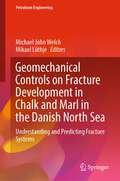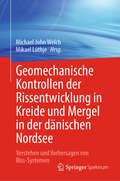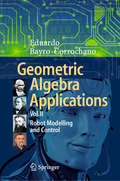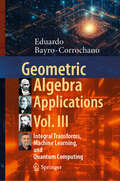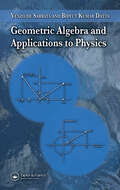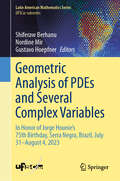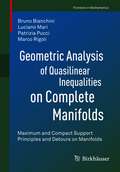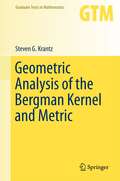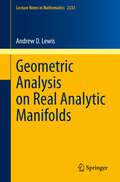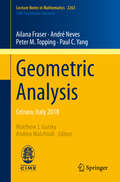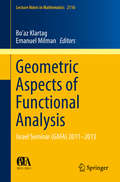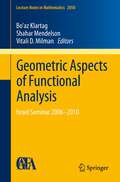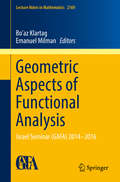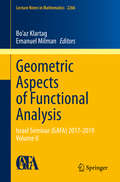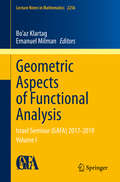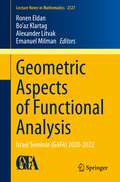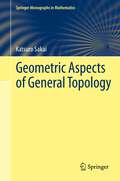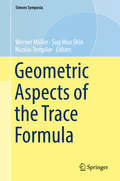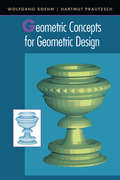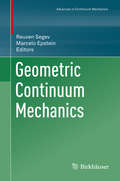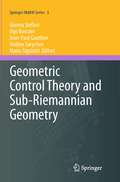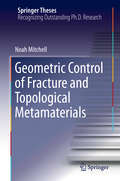- Table View
- List View
Geomechanical Controls on Fracture Development in Chalk and Marl in the Danish North Sea: Understanding and Predicting Fracture Systems (Petroleum Engineering)
by Michael John Welch Mikael LüthjeThis book summarizes new discoveries on fracturing in chalk. Based on studies on the Danish North Sea, this book shows how observations from outcrop analogues, core and seismic data can be used to characterize the density, distribution and geometry of natural fractures in chalk and marl. Laboratory experiments on chalk samples reveal the controls on the geomechanical properties of chalk and thus on the growth of natural fractures. Finally, various modeling techniques are employed to investigate the mechanical deformation in the chalk structures of the Danish North Sea and to predict fracture distribution and geometry in the subsurface. An understanding of fracture density, distribution and geometry is essential for planning efficient fluid extraction or injection strategies and CO2 sequestration. This book provides the necessary knowledge.
Geomechanische Kontrollen der Rissentwicklung in Kreide und Mergel in der dänischen Nordsee: Verstehen und Vorhersagen von Riss-Systemen
by Michael John Welch Mikael LüthjeDieses Buch fasst neue Entdeckungen zur Rissbildung in Kreide zusammen. Basierend auf Studien in der dänischen Nordsee zeigt das Buch, wie Beobachtungen von Aufschlussanaloga, Bohrkernen und seismischen Daten genutzt werden können, um die Dichte, Verteilung und Geometrie natürlicher Risse in Kreide und Mergel zu charakterisieren. Laborversuche mit Kreideproben zeigen die Einflussfaktoren auf die geomechanischen Eigenschaften der Kreide und damit auf das Wachstum natürlicher Risse. Schließlich werden verschiedene Modellierungstechniken eingesetzt, um die mechanische Deformation in den Kreide-Strukturen der dänischen Nordsee zu untersuchen und die Rissverteilung sowie -geometrie im Untergrund vorherzusagen. Ein Verständnis der Rissdichte, -verteilung und -geometrie ist entscheidend für die Planung effizienter Strategien zur Fluidextraktion oder -injektion sowie zur CO2-Speicherung. Dieses Buch liefert das notwendige Wissen.
Geometric Algebra (Dover Books on Mathematics)
by Emil ArtinThis concise classic presents advanced undergraduates and graduate students in mathematics with an overview of geometric algebra. The text originated with lecture notes from a New York University course taught by Emil Artin, one of the preeminent mathematicians of the twentieth century. The Bulletin of the American Mathematical Society praised Geometric Algebra upon its initial publication, noting that "mathematicians will find on many pages ample evidence of the author's ability to penetrate a subject and to present material in a particularly elegant manner."Chapter 1 serves as reference, consisting of the proofs of certain isolated algebraic theorems. Subsequent chapters explore affine and projective geometry, symplectic and orthogonal geometry, the general linear group, and the structure of symplectic and orthogonal groups. The author offers suggestions for the use of this book, which concludes with a bibliography and index.
Geometric Algebra Applications Vol. II: Robot Modelling and Control
by Eduardo Bayro-CorrochanoThis book presents a unified mathematical treatment of diverse problems in the general domain of robotics and associated fields using Clifford or geometric alge- bra. By addressing a wide spectrum of problems in a common language, it offers both fresh insights and new solutions that are useful to scientists and engineers working in areas related with robotics. It introduces non-specialists to Clifford and geometric algebra, and provides ex- amples to help readers learn how to compute using geometric entities and geomet- ric formulations. It also includes an in-depth study of applications of Lie group theory, Lie algebra, spinors and versors and the algebra of incidence using the universal geometric algebra generated by reciprocal null cones. Featuring a detailed study of kinematics, differential kinematics and dynamics using geometric algebra, the book also develops Euler Lagrange and Hamiltoni- ans equations for dynamics using conformal geometric algebra, and the recursive Newton-Euler using screw theory in the motor algebra framework. Further, it comprehensively explores robot modeling and nonlinear controllers, and discusses several applications in computer vision, graphics, neurocomputing, quantum com- puting, robotics and control engineering using the geometric algebra framework. The book also includes over 200 exercises and tips for the development of future computer software packages for extensive calculations in geometric algebra, and a entire section focusing on how to write the subroutines in C++, Matlab and Maple to carry out efficient geometric computations in the geometric algebra framework. Lastly, it shows how program code can be optimized for real-time computations. An essential resource for applied physicists, computer scientists, AI researchers, roboticists and mechanical and electrical engineers, the book clarifies and demon- strates the importance of geometric computing for building autonomous systems to advance cognitive systems research.
Geometric Algebra Applications Vol. III: Integral Transforms, Machine Learning, and Quantum Computing
by Eduardo Bayro-CorrochanoThe goal of Geometric Algebra Applications Vol. III: Integral Transforms, Machine Learning, and Quantum Computing is to present a unified mathematical treatment of diverse problems in the general domain like Clifford Fourier Transforms, Deep Learning and Geometric Algebra Convolutional Neural Networks, Quaternion Quantum Fourier Transform and Geometric Quantum Computing. Topics and features · Introduces nonspecialists to Clifford, or geometric algebra and by example encourages the reader to learn to compute using geometric entities and geometric formulations. · A study in depth for applications of Lie group theory, Lie algebra, projective geometry, and the algebra of incidence using the conformal geometric algebra. · Features the computing frameworks of the linear model n-dimensional affine plane and the nonlinear model of Euclidean space known as the horosphere, and addresses the relationships of these models to conformal, affine, and projective geometries. · Includes a thorough study of Integral transforms: Quaternion and Clifford Transforms, quaternion analytic signal, monogenic signals, Hilbert transform, Riesz transform, Clifford Fourier Transform, Quaternion Wavelet transforms, Quaternion Quantum Fourier Transform, 3D Radon Transform and Hough-Transform in geometric algebra. · Color image processing using the color model HSV, Quaternion Split rotors and motors, and the space-time Lorentz transform. · Geometric neural computing using Split Quaternions, Geometric Algebra neural networks, Clifford Support Vector Machine and Neuro Control. · Thorough discussion of several tasks of computer vision, graphics, neurocomputing, and robotics. machine learning, Deep Learning and CNNs, and Geometric Quantum Computing using the geometric algebra framework. · 130 exercises and hints for the development of future computer software packages for extensive calculations in geometric algebra. An entire section is dedicated to explaining how one should write the subroutines in C++, Phyton, Matlab, and Maple to carry out efficient geometric computations in the geometric algebra framework. Furthermore, it is shown how program code can be optimized for real-time computations. The book is an essential resource for applied mathematicians, physicists, computer scientists, graphics engineering, AI and Machine Learning researchers, roboticists and mechanical and electrical engineers, neurocomputing researchers, neuroscientists, and quantum computing specialists. It clarifies and demonstrates the importance of geometric computing for building autonomous systems and pushes forward advances in geometric cybernetics research.
Geometric Algebra and Applications to Physics
by Venzo de Sabbata Bidyut Kumar DattaBringing geometric algebra to the mainstream of physics pedagogy, Geometric Algebra and Applications to Physics not only presents geometric algebra as a discipline within mathematical physics, but the book also shows how geometric algebra can be applied to numerous fundamental problems in physics, especially in experimental situations. This
Geometric Algebra for Physicists
by Chris Doran Anthony LasenbyGeometric algebra is a powerful mathematical language with applications across a range of subjects in physics and engineering. This book is a complete guide to the current state of the subject with early chapters providing a self-contained introduction to geometric algebra. Topics covered include new techniques for handling rotations in arbitrary dimensions, and the links between rotations, bivectors and the structure of the Lie groups. Following chapters extend the concept of a complex analytic function theory to arbitrary dimensions, with applications in quantum theory and electromagnetism. Later chapters cover advanced topics such as non-Euclidean geometry, quantum entanglement, and gauge theories. Applications such as black holes and cosmic strings are also explored. It can be used as a graduate text for courses on the physical applications of geometric algebra and is also suitable for researchers working in the fields of relativity and quantum theory.
Geometric Analysis of PDEs and Several Complex Variables: In Honor of Jorge Hounie's 75th Birthday, Serra Negra, Brazil, July 31–August 4, 2023 (Latin American Mathematics Series)
by Nordine Mir Shiferaw Berhanu Gustavo HoepfnerThis volume convenes selected, peer-reviewed papers presented at the international workshop dedicated to Dr. Jorge Hounie on the occasion of his 75th birthday, held in Serra Negra, Brazil, from July 31 to August 4, 2023. The papers in this volume cover areas that include several complex variables, Cauchy-Riemann geometry, and partial differential equations. An Emeritus at the Federal University of São Carlos (UFScar), Brazil, Dr. Hounie has made significant contributions to partial differential equations, complex variables, harmonic analysis, and involutive structures. He has also been a kind and great mentor to numerous graduate students and postdocs who have gone on to pursue successful academic careers. Born in Bahia Blanca, Argentina, he completed his PhD studies at Rutgers University in 1974 and joined UFSCar as a Full Professor in 1995. He is a Full Member of the Brazilian Academy of Sciences. Within this book, readers will encounter a collection of cutting-edge research papers reflecting Dr. Hounie's research interests, valuable for both experienced researchers and graduate students alike.
Geometric Analysis of Quasilinear Inequalities on Complete Manifolds: Maximum and Compact Support Principles and Detours on Manifolds (Frontiers in Mathematics)
by Marco Rigoli Patrizia Pucci Bruno Bianchini Luciano MariThis book demonstrates the influence of geometry on the qualitative behaviour of solutions of quasilinear PDEs on Riemannian manifolds. Motivated by examples arising, among others, from the theory of submanifolds, the authors study classes of coercive elliptic differential inequalities on domains of a manifold M with very general nonlinearities depending on the variable x, on the solution u and on its gradient. The book highlights the mean curvature operator and its variants, and investigates the validity of strong maximum principles, compact support principles and Liouville type theorems. In particular, it identifies sharp thresholds involving curvatures or volume growth of geodesic balls in M to guarantee the above properties under appropriate Keller-Osserman type conditions, which are investigated in detail throughout the book, and discusses the geometric reasons behind the existence of such thresholds. Further, the book also provides a unified review of recent results in the literature, and creates a bridge with geometry by studying the validity of weak and strong maximum principles at infinity, in the spirit of Omori-Yau’s Hessian and Laplacian principles and subsequent improvements.
Geometric Analysis of the Bergman Kernel and Metric
by Steven G. KrantzThis text provides a masterful and systematic treatment of all the basic analytic and geometric aspects of Bergman's classic theory of the kernel and its invariance properties. These include calculation, invariance properties, boundary asymptotics, and asymptotic expansion of the Bergman kernel and metric. Moreover, it presents a unique compendium of results with applications to function theory, geometry, partial differential equations, and interpretations in the language of functional analysis, with emphasis on the several complex variables context. Several of these topics appear here for the first time in book form. Each chapter includes illustrative examples and a collection of exercises which will be of interest to both graduate students and experienced mathematicians. Graduate students who have taken courses in complex variables and have a basic background in real and functional analysis will find this textbook appealing. Applicable courses for either main or supplementary usage include those in complex variables, several complex variables, complex differential geometry, and partial differential equations. Researchers in complex analysis, harmonic analysis, PDEs, and complex differential geometry will also benefit from the thorough treatment of the many exciting aspects of Bergman's theory.
Geometric Analysis on Real Analytic Manifolds (Lecture Notes in Mathematics #2333)
by Andrew D. LewisThis monograph provides some useful tools for performing global geometric analysis on real analytic manifolds. At the core of the methodology of the book is a variety of descriptions for the topologies for the space of real analytic sections of a real analytic vector bundle and for the space of real analytic mappings between real analytic manifolds. Among the various descriptions for these topologies is a development of geometric seminorms for the space of real analytic sections. To illustrate the techniques in the book, a number of fundamental constructions in differential geometry are shown to induce continuous mappings on spaces of real analytic sections and mappings.Aimed at researchers at the level of Doctoral students and above, the book introduces the reader to the challenges and opportunities of real analytic analysis and geometry.
Geometric Analysis: Cetraro, Italy 2018 (Lecture Notes in Mathematics #2263)
by Paul C. Yang Ailana Fraser André Neves Peter M. ToppingThis book covers recent advances in several important areas of geometric analysis including extremal eigenvalue problems, mini-max methods in minimal surfaces, CR geometry in dimension three, and the Ricci flow and Ricci limit spaces. An output of the CIME Summer School "Geometric Analysis" held in Cetraro in 2018, it offers a collection of lecture notes prepared by Ailana Fraser (UBC), André Neves (Chicago), Peter M. Topping (Warwick), and Paul C. Yang (Princeton). These notes will be a valuable asset for researchers and advanced graduate students in geometric analysis.
Geometric Aspects of Functional Analysis
by Bo'Az Klartag Emanuel MilmanAs in the previous Seminar Notes, the current volume reflects general trends in the study of Geometric Aspects of Functional Analysis. Most of the papers deal with different aspects of Asymptotic Geometric Analysis, understood in a broad sense; many continue the study of geometric and volumetric properties of convex bodies and log-concave measures in high-dimensions and in particular the mean-norm, mean-width, metric entropy, spectral-gap, thin-shell and slicing parameters, with applications to Dvoretzky and Central-Limit-type results. The study of spectral properties of various systems, matrices, operators and potentials is another central theme in this volume. As expected, probabilistic tools play a significant role and probabilistic questions regarding Gaussian noise stability, the Gaussian Free Field and First Passage Percolation are also addressed. The historical connection to the field of Classical Convexity is also well represented with new properties and applications of mixed-volumes. The interplay between the real convex and complex pluri-subharmonic settings continues to manifest itself in several additional articles. All contributions are original research papers and were subject to the usual refereeing standards.
Geometric Aspects of Functional Analysis
by Vitali D. Milman Bo'Az Klartag Shahar MendelsonThis collection of original papers related to the Israeli GAFA seminar (on Geometric Aspects of Functional Analysis) from the years 2006 to 2011 continues the long tradition of the previous volumes, which reflect the general trends of Asymptotic Geometric Analysis, understood in a broad sense, and are a source of inspiration for new research. Most of the papers deal with various aspects of the theory, including classical topics in the geometry of convex bodies, inequalities involving volumes of such bodies or more generally, logarithmically-concave measures, valuation theory, probabilistic and isoperimetric problems in the combinatorial setting, volume distribution on high-dimensional spaces and characterization of classical constructions in Geometry and Analysis (like the Legendre and Fourier transforms, derivation and others). All the papers here are original research papers.
Geometric Aspects of Functional Analysis
by Bo'Az Klartag Emanuel MilmanAs in the previous Seminar Notes, the current volume reflects general trends in the study of Geometric Aspects of Functional Analysis, understood in a broad sense. A classical theme in the Local Theory of Banach Spaces which is well represented in this volume is the identification of lower-dimensional structures in high-dimensional objects. More recent applications of high-dimensionality are manifested by contributions in Random Matrix Theory, Concentration of Measure and Empirical Processes. Naturally, the Gaussian measure plays a central role in many of these topics, and is also studied in this volume; in particular, the recent breakthrough proof of the Gaussian Correlation Conjecture is revisited. The interplay of the theory with Harmonic and Spectral Analysis is also well apparent in several contributions. The classical relation to both the primal and dual Brunn-Minkowski theories is also well represented, and related algebraic structures pertaining to valuations and valent functions are discussed. All contributions are original research papers and were subject to the usual refereeing standards.
Geometric Aspects of Functional Analysis: Israel Seminar (GAFA) 2017-2019 Volume II (Lecture Notes in Mathematics #2266)
by Emanuel Milman Bo’az KlartagContinuing the theme of the previous volumes, these seminar notes reflect general trends in the study of Geometric Aspects of Functional Analysis, understood in a broad sense. Two classical topics represented are the Concentration of Measure Phenomenon in the Local Theory of Banach Spaces, which has recently had triumphs in Random Matrix Theory, and the Central Limit Theorem, one of the earliest examples of regularity and order in high dimensions. Central to the text is the study of the Poincaré and log-Sobolev functional inequalities, their reverses, and other inequalities, in which a crucial role is often played by convexity assumptions such as Log-Concavity. The concept and properties of Entropy form an important subject, with Bourgain's slicing problem and its variants drawing much attention. Constructions related to Convexity Theory are proposed and revisited, as well as inequalities that go beyond the Brunn–Minkowski theory. One of the major current research directions addressed is the identification of lower-dimensional structures with remarkable properties in rather arbitrary high-dimensional objects. In addition to functional analytic results, connections to Computer Science and to Differential Geometry are also discussed.
Geometric Aspects of Functional Analysis: Israel Seminar (GAFA) 2017-2019 Volume I (Lecture Notes in Mathematics #2256)
by Emanuel Milman Bo’az KlartagContinuing the theme of the previous volumes, these seminar notes reflect general trends in the study of Geometric Aspects of Functional Analysis, understood in a broad sense. Two classical topics represented are the Concentration of Measure Phenomenon in the Local Theory of Banach Spaces, which has recently had triumphs in Random Matrix Theory, and the Central Limit Theorem, one of the earliest examples of regularity and order in high dimensions. Central to the text is the study of the Poincaré and log-Sobolev functional inequalities, their reverses, and other inequalities, in which a crucial role is often played by convexity assumptions such as Log-Concavity. The concept and properties of Entropy form an important subject, with Bourgain's slicing problem and its variants drawing much attention. Constructions related to Convexity Theory are proposed and revisited, as well as inequalities that go beyond the Brunn–Minkowski theory. One of the major current research directions addressed is the identification of lower-dimensional structures with remarkable properties in rather arbitrary high-dimensional objects. In addition to functional analytic results, connections to Computer Science and to Differential Geometry are also discussed.
Geometric Aspects of Functional Analysis: Israel Seminar (GAFA) 2020-2022 (Lecture Notes in Mathematics #2327)
by Emanuel Milman Bo’az Klartag Ronen Eldan Alexander LitvakThis book reflects general trends in the study of geometric aspects of functional analysis, understood in a broad sense. A classical theme in the local theory of Banach spaces is the study of probability measures in high dimension and the concentration of measure phenomenon. Here this phenomenon is approached from different angles, including through analysis on the Hamming cube, and via quantitative estimates in the Central Limit Theorem under thin-shell and related assumptions. Classical convexity theory plays a central role in this volume, as well as the study of geometric inequalities. These inequalities, which are somewhat in spirit of the Brunn-Minkowski inequality, in turn shed light on convexity and on the geometry of Euclidean space. Probability measures with convexity or curvature properties, such as log-concave distributions, occupy an equally central role and arise in the study of Gaussian measures and non-trivial properties of the heat flow in Euclidean spaces. Also discussed are interactions of this circle of ideas with linear programming and sampling algorithms, including the solution of a question in online learning algorithms using a classical convexity construction from the 19th century.
Geometric Aspects of General Topology
by Katsuro SakaiThis book is designed for graduate students to acquire knowledge of dimension theory, ANR theory (theory of retracts), and related topics. These two theories are connected with various fields in geometric topology and in general topology as well. Hence, for students who wish to research subjects in general and geometric topology, understanding these theories will be valuable. Many proofs are illustrated by figures or diagrams, making it easier to understand the ideas of those proofs. Although exercises as such are not included, some results are given with only a sketch of their proofs. Completing the proofs in detail provides good exercise and training for graduate students and will be useful in graduate classes or seminars. Researchers should also find this book very helpful, because it contains many subjects that are not presented in usual textbooks, e.g., dim X × I = dim X + 1 for a metrizable space X; the difference between the small and large inductive dimensions; a hereditarily infinite-dimensional space; the ANR-ness of locally contractible countable-dimensional metrizable spaces; an infinite-dimensional space with finite cohomological dimension; a dimension raising cell-like map; and a non-AR metric linear space. The final chapter enables students to understand how deeply related the two theories are. Simplicial complexes are very useful in topology and are indispensable for studying the theories of both dimension and ANRs. There are many textbooks from which some knowledge of these subjects can be obtained, but no textbook discusses non-locally finite simplicial complexes in detail. So, when we encounter them, we have to refer to the original papers. For instance, J.H.C. Whitehead's theorem on small subdivisions is very important, but its proof cannot be found in any textbook. The homotopy type of simplicial complexes is discussed in textbooks on algebraic topology using CW complexes, but geometrical arguments using simplicial complexes are rather easy.
Geometric Aspects of the Trace Formula (Simons Symposia)
by Werner Müller Sug Woo Shin Nicolas TemplierThe second of three volumes devoted to the study of the trace formula, these proceedings focus on automorphic representations of higher rank groups. Based on research presented at the 2016 Simons Symposium on Geometric Aspects of the Trace Formula that took place in Schloss Elmau, Germany, the volume contains both original research articles and articles that synthesize current knowledge and future directions in the field. The articles discuss topics such as the classification problem of representations of reductive groups, the structure of Langlands and Arthur packets, interactions with geometric representation theory, and conjectures on the global automorphic spectrum. Suitable for both graduate students and researchers, this volume presents the latest research in the field. Readers of the first volume Families of Automorphic Forms and the Trace Formula will find this a natural continuation of the study of the trace formula.
Geometric Complex Analysis: In Honor of Kang-Tae Kim’s 60th Birthday, Gyeongju, Korea, 2017 (Springer Proceedings in Mathematics & Statistics #246)
by Jisoo Byun Hong Rae Cho Sung Yeon Kim Kang-Hyurk Lee Jong-Do ParkThe KSCV Symposium, the Korean Conference on Several Complex Variables, started in 1997 in an effort to promote the study of complex analysis and geometry. Since then, the conference met semi-regularly for about 10 years and then settled on being held biannually. The sixth and tenth conferences were held in 2002 and 2014 as satellite conferences to the Beijing International Congress of Mathematicians (ICM) and the Seoul ICM, respectively. The purpose of the KSCV Symposium is to organize the research talks of many leading scholars in the world, to provide an opportunity for communication, and to promote new researchers in this field.
Geometric Concepts for Geometric Design
by Hartmut Prautzsch Wolfgang BoehmThis book is a comprehensive tool both for self-study and for use as a text in classical geometry. It explains the concepts that form the basis for computer-aided geometric design.
Geometric Continuum Mechanics (Advances in Mechanics and Mathematics #42)
by Marcelo Epstein Reuven SegevThis contributed volume explores the applications of various topics in modern differential geometry to the foundations of continuum mechanics. In particular, the contributors use notions from areas such as global analysis, algebraic topology, and geometric measure theory. Chapter authors are experts in their respective areas, and provide important insights from the most recent research. Organized into two parts, the book first covers kinematics, forces, and stress theory, and then addresses defects, uniformity, and homogeneity. Specific topics covered include:Global stress and hyper-stress theoriesApplications of de Rham currents to singular dislocationsManifolds of mappings for continuum mechanicsKinematics of defects in solid crystalsGeometric Continuum Mechanics will appeal to graduate students and researchers in the fields of mechanics, physics, and engineering who seek a more rigorous mathematical understanding of the area. Mathematicians interested in applications of analysis and geometry will also find the topics covered here of interest.
Geometric Control Theory and Sub-Riemannian Geometry
by Mario Sigalotti Gianna Stefani Ugo Boscain Jean-Paul Gauthier Andrey SarychevHonoring Andrei Agrachev's 60th birthday, this volume presents recent advances in the interaction between Geometric Control Theory and sub-Riemannian geometry. On the one hand, Geometric Control Theory used the differential geometric and Lie algebraic language for studying controllability, motion planning, stabilizability and optimality for control systems. The geometric approach turned out to be fruitful in applications to robotics, vision modeling, mathematical physics etc. On the other hand, Riemannian geometry and its generalizations, such as sub-Riemannian, Finslerian geometry etc. , have been actively adopting methods developed in the scope of geometric control. Application of these methods has led to important results regarding geometry of sub-Riemannian spaces, regularity of sub-Riemannian distances, properties of the group of diffeomorphisms of sub-Riemannian manifolds, local geometry and equivalence of distributions and sub-Riemannian structures, regularity of the Hausdorff volume, etc.
Geometric Control of Fracture and Topological Metamaterials (Springer Theses)
by Noah MitchellThis thesis reports a rare combination of experiment and theory on the role of geometry in materials science. It is built on two significant findings: that curvature can be used to guide crack paths in a predictive way, and that protected topological order can exist in amorphous materials. In each, the underlying geometry controls the elastic behavior of quasi-2D materials, enabling the control of crack propagation in elastic sheets and the control of unidirectional waves traveling at the boundary of metamaterials. The thesis examines the consequences of this geometric control in a range of materials spanning many orders of magnitude in length scale, from amorphous macroscopic networks and elastic continua to nanoscale lattices.
